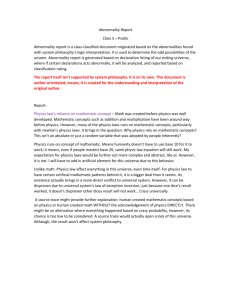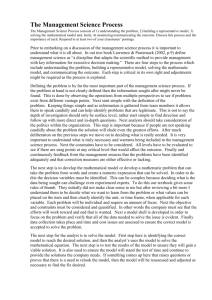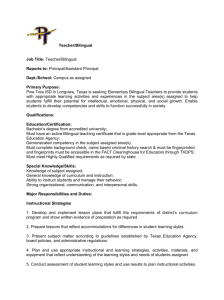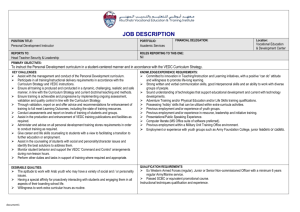- Institutional Repository of IAIN Tulungagung
advertisement
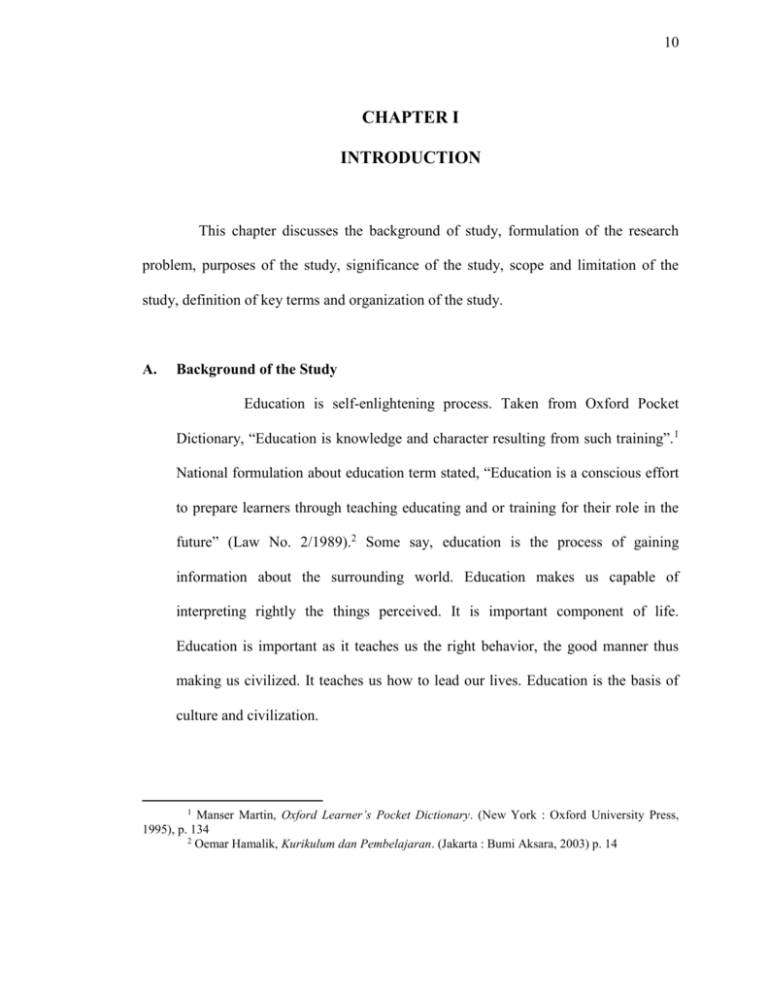
10 CHAPTER I INTRODUCTION This chapter discusses the background of study, formulation of the research problem, purposes of the study, significance of the study, scope and limitation of the study, definition of key terms and organization of the study. A. Background of the Study Education is self-enlightening process. Taken from Oxford Pocket Dictionary, “Education is knowledge and character resulting from such training”.1 National formulation about education term stated, “Education is a conscious effort to prepare learners through teaching educating and or training for their role in the future” (Law No. 2/1989).2 Some say, education is the process of gaining information about the surrounding world. Education makes us capable of interpreting rightly the things perceived. It is important component of life. Education is important as it teaches us the right behavior, the good manner thus making us civilized. It teaches us how to lead our lives. Education is the basis of culture and civilization. Manser Martin, Oxford Learner’s Pocket Dictionary. (New York : Oxford University Press, 1995), p. 134 2 Oemar Hamalik, Kurikulum dan Pembelajaran. (Jakarta : Bumi Aksara, 2003) p. 14 1 10 School and colleges define the basis framework of education. It is the most important institution in process of education. Schooling gives us the base of knowledge, shapes our characters and improves our interest. For many people, school is convinced as an exact institution for determining their children future. Education has big a influence for human life. Because of this reason, education becomes Indonesian Government’s development agenda. The Law on National Education System No. 20/2003 and the Constitution Amendment III emphasize that all Indonesian citizens have right to get education.3 The Government has an obligation to finance basic education without charging fees and the Government is mandated to allocate 20% of its expenditure on education. The Teacher Law No. 14/2005 introduces important changes to the employment conditions and requirements for the certification of teachers, aiming at improving education quality. The Ministry of National Education’s strategic plan for 2005-2009 has three main pillars.4 They are: (a) to increase access to education, (b) to improve education quality, and (c) to create better governance of the education sector. In accordance with the strategic plan above, in 2003 the Ministry of National Education made a regulation in pioneering schools to have an international standard. Implementation of International Standard School is based 3 Undang-Undang Republik Indonesia Tentang Sistem Pendidikan Nasional No. 20 Th. 2003, (Jakarta : Penerbit Asa Mandiri, 2009), p. 23 4 World Bank and Education in Indonesia in http://www.web.worldbang.org/WBsite, acces on nd April 2 , 2010 10 on the Law of National Education System No. 20/2003. In this regulation, government holds a high quality of education that produces graduates is admitted nationally and international. According to Satria, an International Standard School is a school that holds its schooling based on National Standard of Education and it has international quality.5 National Standard of Education is a national standard consists of eight main components. They are: standard of material, process, graduates competency, educator and educational staffs, facilities and infrastructure, management, financing and assessment.6 Fulfillment of the National Standard of Education is minimum indicator for International Standard School. Its extra indicator is education standard from members of OECD (Organization for Economic Co-operation and Development) countries or other advanced countries. The implementation of the International Standard School is done in all of education levels, including Junior High School. Haryana stated that the implementation of International Standard School on Junior High School level has been pioneered since 2007.7 There are 100 state schools and 2 private schools to be the pioneer of the International Standard School, whereas there are more than 22.000 schools both state school and private in this level. The minimum number of Junior High School that determine as Pioneering International Standard School is 5 Satria Darma, Sekolah Bertaraf Internasional SMA 1 Pandaan, in http://www.smanda.sch.id access on April 12th, 2010 6 Standar Nasional Pendidikan. Peraturan Pemerintah Republik Indonesia No. 19 Th. 2005, (Jakarta : Penerbit Asa Mandiri, 2009), p. 101 7 Kir Haryana, Panduan Penyelenggaraan Rintisan Sekolah Bertaraf Internasional, in http://pelangi.dilp.go.id access on May 3rd, 2010 10 caused by constraint in fulfillment rule and regulations or criteria to be an International Standard School. Junior High School 1 Tulungagung is one of school that determine as Pioneering International Standard School. According to the International Standard School guide book, teaching learning process of Mathematic and Science have to use bilingual: Indonesia and English.8 The focus of this study is the use of English only. The use of Indonesian is not a problem for the students and teachers, so the researcher focuses her study in the use of English as an instructional medium of Mathematic and Science bilingual instruction program. For some students, learning Mathematic and Science is difficult. It will be more complicated if the instructional medium is by using English. For English teacher, it does not matter to use English in instructional process because they have competency in it. On the contrary, for Mathematic and Science teachers, it needs a lot of efforts to realize the use of English in the classroom. Mathematic and Science teachers come from different background of education who are not prepared to teach Mathematic and Science in English. In accordance with these problems, the researcher is interested in doing a research about the implementation of English as an instructional medium in the Pioneering International Standard School classroom at Junior High School 1 Tulungagung. 8 Departemen Pendidikan Nasional, Pembelajaran Matematika dan IPA dalam Bahasa Inggris (Bilingual), (Jakarta : Direktorat Pembinaan Sekolah Menengah Pertama, 2004) p.15 10 So, this study is intended to know how the implementation of Mathematic and Science instruction using English in the Pioneering International Standard School classroom at Junior High School 1 Tulungagung. It is also used to find out the students and teachers advantages and constraints in implementing Mathematic and Science instruction using English. B. Formulation of the Research Problem Based on the background of the study above, this study is directed to give description about the implementing of English in teaching learning process at Junior High School 1 Tulungagung. The problems of this study can be formulated as follows: 1. How is English used in Mathematic and Science bilingual instruction program of Pioneering International Standard School classroom at the Junior High School 1 Tulungagung? 2. What are the constraints faced by teachers and students in using English in Mathematic and Science bilingual instruction program of Pioneering International Standard School classroom at the Junior High School 1 Tulungagung? 3. What are advantages gotten by teachers and students in using English as an instructional medium in Mathematic and Science bilingual instruction program of Pioneering International Standard School classroom at the Junior High School 1 Tulungagung? 10 C. Purposes of the Study Based on the research problem above, this study has some purposes. They are: 1. To find out how English is used in Mathematic and Science bilingual instruction program of Pioneering International Standard School classroom at the Junior High School 1 Tulungagung. 2. To find out teachers and students constraints in using English in Mathematic and Science bilingual instruction program of Pioneering International Standard School classroom at the Junior High School 1 Tulungagung. 3. To find out teachers and students advantages in using English as an instructional medium in Mathematic and Science bilingual instruction program of Pioneering International Standard School classroom at the Junior High School 1 Tulungagung. D. Significance of the Study The researcher hopes that the result of this study will be useful both theoretically and practically. 1. Theoretically The use of English as a means of instructional of Mathematic and Science teaching learning process is a new matter in Indonesia. The result of this study is expected can be used as an input or information in linguistic that 10 the use of English as a means of teaching non-English subjects in Indonesia develops increasingly. 2. Practically a. Principle The result of this study is expected can be used as an evaluation instrument of Mathematic and Science instruction using English at Junior High School 1 Tulungagung. Furthermore, the principle can give a chance to the Mathematic and Science teachers to improve their English competency, such as hold a seminar or training for Mathematic and Science teacher. So that, it can supports the teaching learning process more effective. b. Teachers Mathematic and Science teachers need to prepare their English competency in teaching process. The result of this study is expected can be used as an input for Mathematic and Science teachers to improve their English competency. It also can be used as information to reduce their constraints in teaching learning process of Mathematic and Science using English. c. Students The result of this study can be used by students to find out their constraints, so that they are motivated to overcome their difficulties during teaching and learning process with English as a means of instructional. 10 E. Scope and Limitation of the Study This study was conducted at Junior High School 1 Tulungagung. The researcher took the second year students, one of the Pioneering International Standard School classrooms as subjects of this study. The first year students area still in adaptation process of the bilingual instruction program, and the third year students have reached advanced level of bilingual instruction program, so the second year students is the representative subjects for this study. The researcher took the 8A class. There were 30 students. This study was conducted from April 26th, 2010 up to July 12th, 2010. F. Definition of Key Terms To avoid misunderstanding, the researcher gives the key terms of this study as follows: 1. Conceptually a. International Standard School is school that holds its schooling based on the eight minimum criteria of National Standard of Education and has international quality.9 b. Pioneering International Standard School is school that holds its schooling based on the eight minimum criteria of National Standard of Education and 9 Darma, Sekolah Bertaraf………… 10 has international quality but still in the development phase of its component to fulfill the determined criteria.10 c. Bilingual is speaking or using two languages.11In this case, bilingual in the Pioneering International Standard School classroom is English and Indonesia in Mathematic and Science teaching learning process. 2. Practically This study was done at Pioneering International Standard School Junior High School 1 Tulungagung. It is conducted to know the implementation of using English in the Pioneering International Standard School classroom, how teachers and students apply the English as means of instructional and what the advantages and constraints are gotten by teachers and students in the classroom. The researcher uses descriptive qualitative research design in conducting this study. So, the data is elaborated in words or descriptively. G. Organization of the Study It is necessary to arrange thesis in a systematic way. The organization of the thesis provides the organization of the main issues discussed. This thesis is divided into five chapters. Chapter I is introduction. It consists of background of the study, formulation of the research problems, purposes of the research, significance of 10 Departemen Pendidikan Nasional, Panduan Penyelenggaraan Program Rintisan SMP Bertaraf Internasional, (Jakarta : Direktorat Pembinaan Sekolah Menengah Pertama, 2004) p. 25 11 Martin, Oxford Learner’s…………… p. 36 10 the study, scope and limitation of the study, definition of key terms and organization of the study. Chapter II is review of related literature. It covers the National Standard of Education, International Standard School, Pioneering International Standard School, and bilingual instructional. Chapter III is methodology. It presents research design, subject of the study, data instruments, data collecting methods and data analysis method. Chapter IV is data presentation and discussion. It covers the presentation of data and discussion. Chapter V presents conclusion and suggestion.

